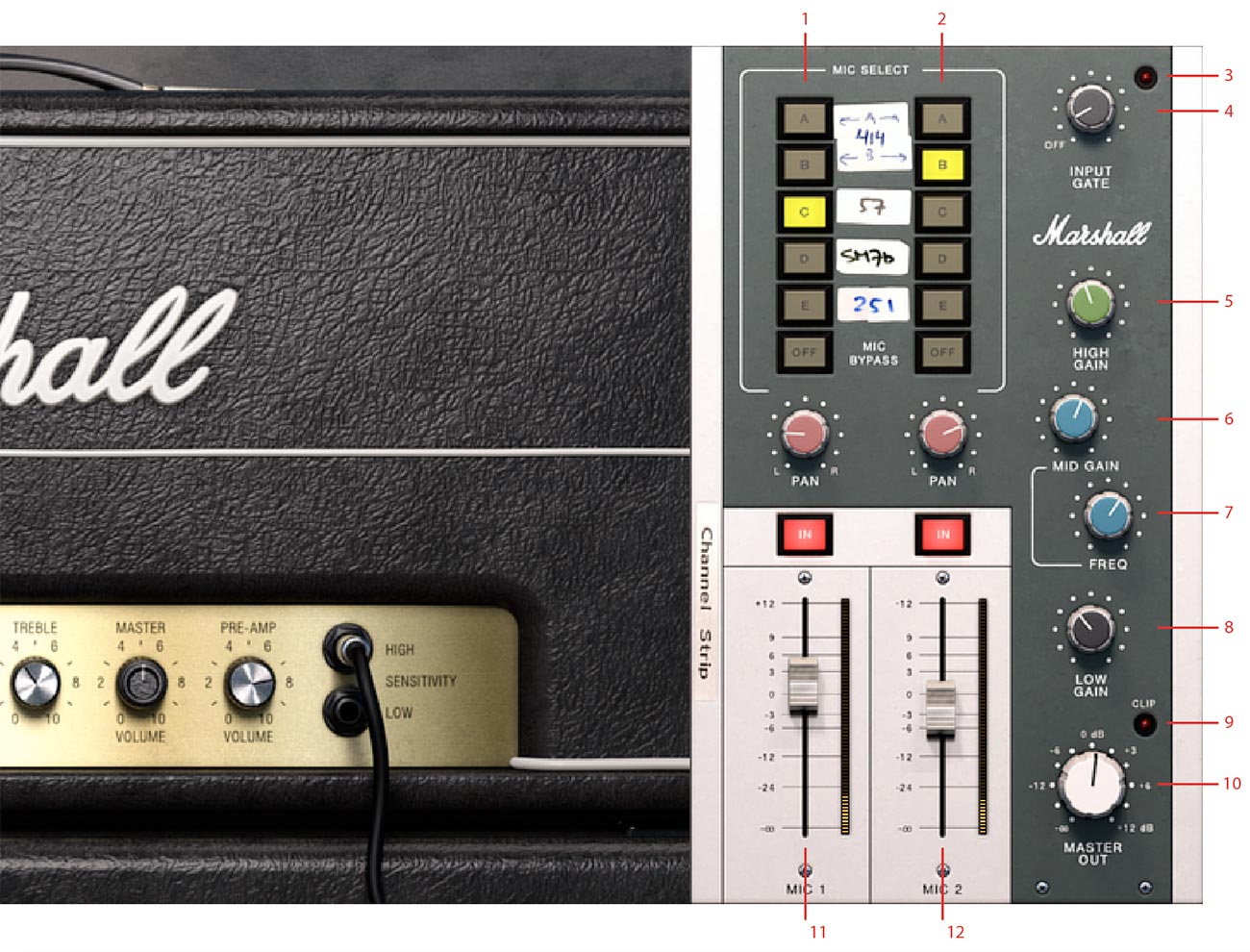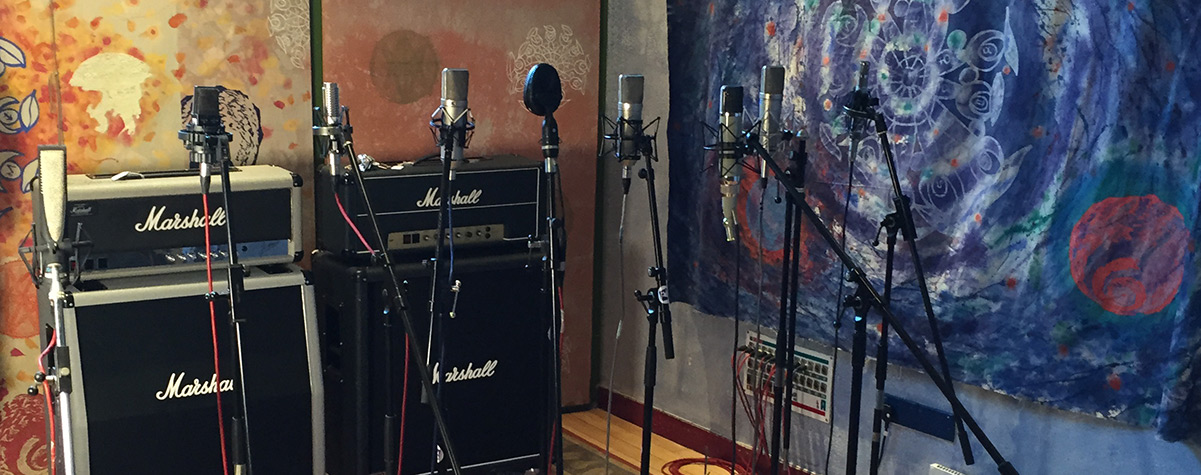User Manual
Marshall JMP 2203
Intro
Amplifier Parameters
Channel Strip Parameters
Marshall JMP 2203 and Amp Room
Extended Features
Related manuals
When Marshall JMP 2203 was introduced in 1975, it didn’t only take over the Plexi’s place as the mainstay of the Marshall range. It became the amp that all other rock guitar amps were gauged against. From 1981, the amp was cosmetically redesigned and named JCM800 2203—probably a more widespread name than the JMP 2203—but the circuit remained identical under the hood.
Rock and Metal
The 2203 became very popular among rock and metal players, and there was hardly a band in those scenes from the mid-70s to the late 80s that didn’t use the 2203. AC/DC first used the amp on the classic Let There Be Rock album and bands like Iron Maiden, Judas Priest, Motley Crue, Slayer and Anthrax were other well-known 2203 users. But the 2203 also reached players outside of the heavy rock scene, such as Jeff Beck and indie rock icons My Bloody Valentine.
Let There Be Rocker Switches
The idea for the 2203, and its 50 watt sibling 2204, mainly came out of the demand for an amp with a master volume. A master volume made it possible to get a distorted sound without the ear-splitting sound pressure levels from a non-master volume amp. But the master volume wasn’t only practical in live situations, it expanded the sonic options largely. By keeping the preamp gain down and get most of the distortion from the power amp, you’d get a more 1960’s Marshall sound. But turning the master volume down and the preamp volume up gave an edgier and more present distortion—and of course any desired balance between the extremes was possible. A new exterior design was employed which clearly marks the Marshall 1970’s: The bigger Marshall logo, the white piping details and the rocker switches which replaced the previous toggle switches.
Marshall’s Reference JMP 2203
Just as with the UAD plug-ins Marshall Plexi Super Lead 1959, Bluesbreaker 1962 and Silver Jubilee 2555, the amplifier that was used in the creation of the Marshall JMP 2203 plug-in came from Marshall’s own “museum”—a collection of reference amplifiers which is not open to the public. This particular amp was built in 1977, and it’s the one Marshall themselves use to define the true 2203 sound.
AC/DC Producer Included
To make sure the plug-in made justice to the 2203, Softube collaborated with iconic rock producer Tony Platt (who among other great rock records engineered AC/DC’s Highway to Hell and Back in Black) and Marshall’s product expert Chris George. Together, they selected the cabinet to be used, a 1960B equipped with Celestion GT12-75 elements. The recordings for the cabinet model were made in Strongroom studios, London, where Tony hand picked the microphones used and placed them where he felt they captured the true JMP 2203 sound. Later in the process, Tony and Chris scrutinized and approved the amplifier model Softube made, and designed most of the included presets.
The Mixer Panel
To add sonic options and a fast workflow, Softube added a mixer panel to the plug-in. Here, the user can pair any two microphones, set their relative volume levels and pan them as desired. Softube also added a flexible and nice sounding equalizer section, three bands with a sweepable Mid. This adds enormously to the plug-ins use, as the player can taylor the sound without ever leaving the plug-in window. Softube also added a gate, which can be turned up for those tight and choppy metal riffs, but also set looser to just get rid of handling noises from the guitar in between takes.
The functionality of the front panel controls corresponds exactly to that of the real amplifier.
Power: Set to On (red light shining) for power in spades. Bypasses the plug-in when set to off.
Standby: Doubles the Power switch.
Presence: Increases the amount of presence—a treble boost accomplished by reducing the amount of high frequencies being subjected to negative feedback in the power amp section.
Bass, Middle and Treble: Tone controls that determine the frequency content from the amplifier.
Master Volume: Controls the output level of the amplifier’s power amp section. Turn this up for the fat power amp crunch sound.
Preamp Volume: Controls the gain level of the amplifier’s preamp section. Turn this up for the more aggressive preamp crunch sound.
High Sensitivity Input: Gives you a bright and distorted sound. Click the input to connect the guitar cable to this input.
Low Sensitivity Input: Gives you a dark and not very distorted sound. Click the input to connect the guitar cable to this input.
1. On/Off and Standby
2. Presence
3. Bass
4. Middle
5. Treble
6. Master Volume
7. Pre-Amp Volume
8. Input Select

Click here to view the full-sized image in a new tab
The channel strip is located to the right of the amplifier head. Open it by clicking the aluminum side with the white Channel Strip sticker. It can be closed again by clicking the same aluminum side, or dragging the entire panel to the right.
Mic Select: Selects which microphone is in use for each of the two channels. All of the microphones were placed close to the 1960B cabinet with four G12-75 speakers, with the exception of 251, which was used as a room mic.
Pan: Selects the channel’s position in the stereo panorama.
In: Activates/deactivates the corresponding channel.
Volume Fader: Sets the volume level of the channel.
Input Gate: Shuts off the sound when guitar is not played. Lower settings lets through more low level sounds, while higher settings makes the gate more discriminating.
High, Mid and Low Gain: Sets the boost or cut values of each of the three EQ bands.
Mid Freq: Sets the operating frequency of the Mid band.
Clip Indicator: Lights up when the output is too loud.
Master Out: Turns up or down the overall output level.
1. Mic 1 Select
2. Mic 2 Select
3. Gate LED
4. Input Gate
5. High Gain
6. Mid Gain
7. Mid Freq
8. Low Gain
9. Master Out Clip LED
10. Master Out
11. Pan 1, In 1, Level 1
12. Pan 2, In 2, Level 2

Click here to view the full-sized image in a new tab
Off (No Cabinet or Microphone)
Sets the cabinet and microphone emulation in bypass, so that only the direct sound from the Marshall JMP amplifier head is heard. This is usually not regarded as a very pleasant sound, but the setting is useful for combining the amplifier with other cabinet/microphone models, such as the ones available in Softube Vintage Amp Room, Bass Amp Room, Metal Amp Room, Half Stack or Bass Amp Room 8x10. In all these plug-ins, the amplifier section can be bypassed. This would be the recommended setting, when combining the Marshall JMP head with the cabinet in either of those plug-ins. The channel strip can be opened by clicking the right hand wood panel with the green Channel Strip sticker. Clicking this again closes the channel strip.
Mono and Stereo Operation
The Marshall JMP 2203 is preferably run in mono-to-stereo or stereo mode. The amplifier will always be in mono, but the microphones can be panned separately.
Presets
The included presets were created by Tony Platt and Chris George, and provides an excellent way of exploring the tones of this amplifier. If you’re using the 2203 in the Unison slot with an Apollo interface, the input gain will automatically correspond to that of the actual amplifier. If you’re not, you may experience that a preset which is supposed to be clean is rather distorted—in this case, turn down the gain of the guitar input or the recorded guitar part that you’re re-amping with the 2203.
All presets were made in mono, but intended use is to pan the two mics differentely and according to taste!
Hints on Using Multiple Microphones
Using multiple microphones to capture a single sound source, such as this guitar amplifier, can give interesting results but requires some special attention. A phenomenon called phase distortion may occur, which can result in a hollow and metallic sound which may not be desired. Using multiple microphones and panning them away from each other, to the left and right in the stereo image, yields a wide and embracing sound, but may cause problems if the recording is summed to mono. The safest way to obtain a good result is to base the sound setting on a single close microphone for a strong, present and focused image. With this in place, you can experiment further by carefully adding in the other microphone channels.


When purchasing this product, you automatically gain access to running the plugin as modules inside the Amp Room platform. The amp and cab sections are divided into two separate Amp Room modules so they can be matched and arranged together with any other native Amp Room module or other Amp Room-ready modules that you might own.
A whole range of added control can be accessed with Extended Features. Please see the separate "Extended Features" manual for more information.